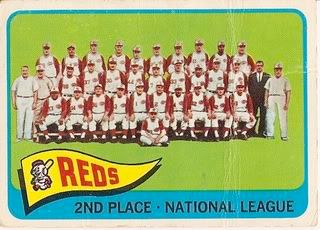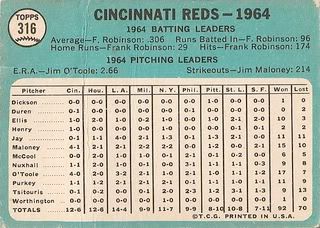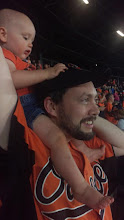
Are there any Reds fans out there who can tell me who the husky fellow is in the back row, far left? While we're at it, why are the trainers wearing caps? (Not that I'm complaining. That's a great look.)
1964 was a rollercoaster of a year for the Reds, who overcame the midseason loss of manager Fred Hutchinson (he stepped aside on August 13, worn out by cancer treatments) and erased an 8.5 game deficit in twelve days in September before a final-week swoon left them a game short of the pennant. The Phillies' late-September collapse was touched off by a three-game sweep at the hands of those Reds, who won nine straight from September 20-27 to briefly claim first place. When they lost two of three to the Pirates and suffered a two-game mini-sweep to the Phils, St. Louis squeaked by and earned a trip to the World Series. Interim manager Dick Sisler would be retained for the following season on the basis of the late-season rally anyhow. Cincy placed seventh in the ten-team National League with a total attendance of 862,466 at Crosley Field, but did draw about 4,000 more fans than they had in 1963.
Cincinnati's hitters were in the middle of the pack in the N.L., ranking fifth with 660 runs scored, fourth with 130 homers, and seventh in each of the "average" categories (.249 AVG/.308 OBP/.372 SLG). Of course the cornerstone of the offense was right fielder Frank Robinson, who paced the club in nearly every offensive category (.306/.396/.548, 103 R, 38 2B, 29 HR, 96 RBI). The other power sources on the team were center fielder Vada Pinson (23 HR, 84 RBI) and first baseman Deron Johnson (21 HR, 79 RBI). Only two Reds made the All-Star team, both as reserves: catcher Johnny Edwards (.281 AVG) and shortstop Leo Cardenas (32 2B, 69 RBI).
While there were no Reds pitchers in the Midsummer Classic, it was on the mound that this team excelled. A 3.07 ERA and 54 complete games were each the second-best totals in the league, and Cincy permitted the fewest overall runs (566) and struck out the most hitters (1,122). The rotation was six-deep, led by Jim O'Toole (17-7, 2.66 ERA) and Jim Maloney (15-10, 2.71 ERA, 214 K). Bob Purkey (11-9, 3.04) and Joey Jay (11-11, 3.39) were also dependable. The fifth-and-sixth-best starters were more than serviceable - John Tsitouris (9-13) had a 3.80 ERA that hovered near league-average and was second on the team with 146 strikeouts, and Joe Nuxhall (9-8) kept the club in games with a 4.07 ERA. On the rare occasion that a reliever was needed, the club was in good hands - the top four bullpen arms each had earned run averages below 3.00, and fireman Sammy Ellis won ten games, saved 14, and posted a 2.57 ERA. What an embarrassment of riches!
Cincinnati dabbled in mediocrity for the rest of the decade before steamrolling the opposition in the 1970s. "The Big Red Machine" won six division titles, four N. L. pennants, and two World Series in those ten years. Not too shabby.



Are pitchers usually put in the back row? It might be Joey Jay, who's listed at 6'4" and 228lbs.
ReplyDeleteJim - Hmm, I don't know. Your guess is as good as mine.
ReplyDelete